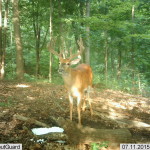
A lot of hunters, including us, put out minerals for deer. We know they attract deer, but do you know why? Which ones are important? Here’s a little science behind it.
The two most common minerals in a deer’s body are calcium (Ca) and phosphorus (P). Deer need these minerals for bone, antler, and milk production.
Nearly all calcium and phosphorus in a deer’s body is in its skeleton. Hardened antlers are composed of about 22 percent calcium and 11 percent phosphorus. Bucks with low Ca and P have delayed antler growth.
Sodium (Na), or salt, is another mineral that all deer require. During the spring and summer, plants are full of water which essentially lowers the sodium levels in a deer’s system. That’s why it is important to have salt out in the spring and through the summer.
Where should you put the licks?
Any high deer traffic area is a good bet for supplementing deer minerals, especially for your momma does and young bucks. For hunting mature bucks though, as you know, these are leery critters, not so apt to frequent places that all the other deer go in daylight hours. For stations we want to hunt over, we like to tuck mineral stations in thick areas where bucks feel safe accessing them during the day. The problem with that, is they are off the beaten deer trail, and not necessarily found very readily. It can take 2-4 years of a momma doe taking young that start to grow up and a few rut seasons of bucks running wild out of their normal home range to commit these secluded spots to the deer memory bank.
Jumpstart the Process
We have found the best way to get a mineral lick use accelerated is to “sweeten” them a little. Though deer can detect and smell salt and minerals; adding corn, an aromatic food block, or even pouring molasses on your newly established lick substantially increases the distance of draw for deer. They smell the food or attractant as they are in the area, which brings them into the minerals. Once they find that source of much needed minerals, they will be back time and again for many years to come, so long as the area is left largely undisturbed and stocked with salt a couple times per year.







